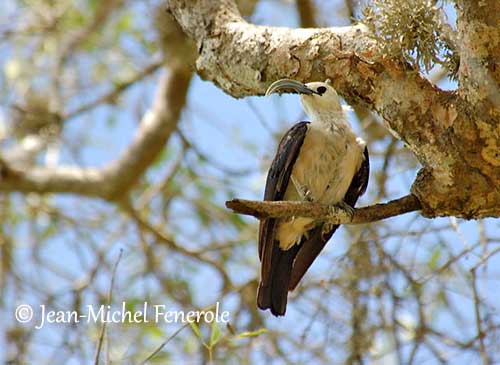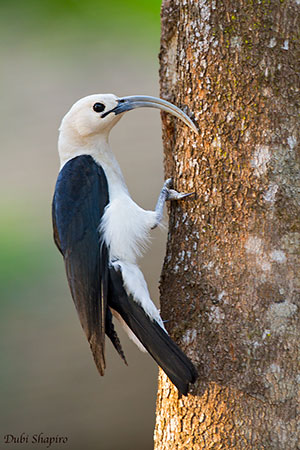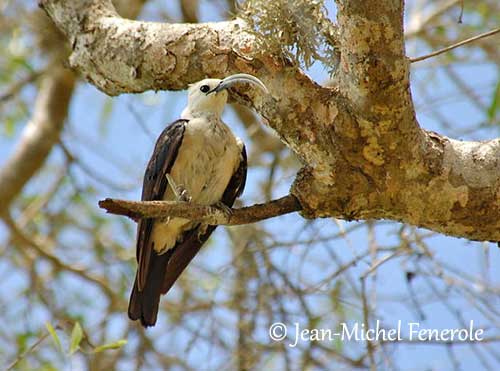
Fr: Falculie mantelée
Ang: Sickle-billed Vanga
All: Sichelschnabelvanga
Esp: Vanga Piquicurvo
Ita: Vanga falcibecca
Nd: Sikkelvanga
Sd: sabelvanga
Mal: Tseatseake, Tsiatsiaka, Voronjaza, Voronjiaza
Photographers:
John Anderson
John Anderson Photo Galleries
Jean Michel Fenerole
Photos d’Oiseaux du monde
William Price
PBase-tereksandpiper & Flickr William Price
Dubi Shapiro
Dubi Shapiro Photo Galleries & Dubi Shapiro's Pictures on IBC
Alan & Ann Tate
AA Bird Photography
Text by Nicole Bouglouan
Sources :
HANDBOOK OF THE BIRDS OF THE WORLD Vol 14 by Josep del Hoyo-Andrew Elliot-David Christie - Lynx Edicions – ISBN: 9788496553507
Birds of the Indian Ocean Islands Par Ian Sinclair, Olivier Langrand - ISBN: 1868729567, 9781868729562- Editeur: Struik, 2003
Birds of Madagascar and the Indian Ocean Islands Par Roger Safford, Adrian Skerrett, Frank Hawkins – ISBN: 1472924118, 9781472924117- Editeur: Bloomsbury Publishing, 2015
The Birds of Africa: Volume VIII: The Malagasy Region: Madagascar, Seychelles, Comoros, Mascarenes - Par Roger Safford, Frank Hawkins – ISBN: 1408190494, 9781408190494- Editeur: A&C Black, 2013
Extreme Endemic Radiation of the Malagasy Vangas
Wikipedia, the free encyclopaedia
Creagus – Bird Families of the World – Vangas - Vanginae
THE VANGAS OF MADAGASCAR by Nick Garbutt
Sickle-billed Vanga
Falculea palliata
Passeriformes Order – Vangidae Family
INTRODUCTION:
The Sickle-billed Vanga is endemic to Madagascar where it frequents dry deciduous forest and thorn-forest, open savanna and wooded patches around villages in the western side of the island.
This monotypic species is the most distinctive member of the family Vangidae, with its long, markedly decurved bill. It is one of the largest vangas. It feeds on a variety of terrestrial invertebrates and some small vertebrates. Its curved bill allows it to extract prey from holes and bark crevices in trees.
The breeding behaviour is slightly reversed, with the female displaying when meeting a male. She is polyandrous and copulates with several males. The group feeds the young and all the males defend the territory while the female performs most of the usual nesting duties.
The Sickle-billed Vanga is common throughout its range and the species is not globally threatened.

DESCRIPTION OF THE BIRD:
Biometrics:
Length: 32 cm
Weight: 106-119 g
Bill length: 70 mm
The Sickle-billed Vanga has black upperparts with blue sheen, but flight-feathers and rectrices are black.
Head, rump and underparts are white, including the underwing-coverts.
The long, down-curved bill is bluish-grey with ivory tip. Gape and mouth are black. The eyes are blackish-brown, surrounded by black orbital ring. Legs and feet are grey to pale blue.
Male and female are similar.
The juvenile resembles adult but it has buff-tipped back and wing feathers.
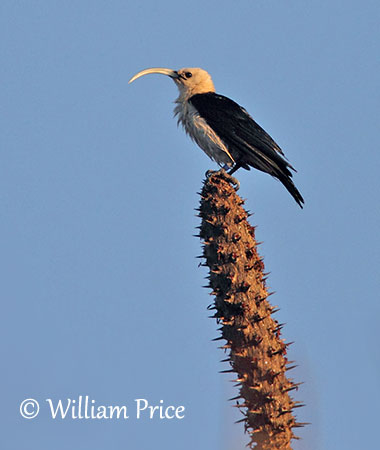
RANGE:
The Sickle-billed Vanga is found throughout the W side of the island, and also in N and S of Madagascar.
HABITAT:
The Sickle-billed Vanga frequents dry, deciduous forest and sub-arid thorn-scrub and thickets, open savanna with scattered trees, and wooded patches around villages.
This species occurs from sea-level up to 900 metres of elevation.
CALLS AND SONGS: SOUNDS BY XENO-CANTO
The Sickle-billed Vanga has distinctive calls including various screeching, crying and chortling sounds such as a loud, hoarse “zhe-zhe…zhe-zhe”, a loud, chanting “chak-chak-chak-chak” or “kyak-kyak-kyak-kyak” and a loud “kwaaah…kwaaah” dropping towards the end and similar to the sound of a baby crying. We can also hear a loud, wheezing “gweeeeech”.
These calls are often given by all the members of a group, especially when they fly to their roosts. This is a combination of cackles, rasps and mournful wails.
The contact call is a nasal “gaaa gaaa gaaa gaaa” and the alarm call is a noisy “kekekeke” that attract many birds which join in the mobbing of a predator.
BEHAVIOUR IN THE WILD:
The Sickle-billed Vanga feeds on invertebrates including spiders and various insects such as Blattodea, Orthopterans, Coleopterans and others. It also takes worms and small vertebrates, especially geckos and chameleons.
It forages by climbing on large branches and trunks, and probes into holes and crevices with its long, down-curved bill. It pulls epiphytes and barks up trees to extract insect larvae, usually in dead trees or dead sections.
The largest prey are held with the feet and dismembered with the bill.
It may form mixed-species foraging flocks of 20-30 individuals, and they spend the night at communal roosts in groups of up to 50 birds. These groups are often noisy.
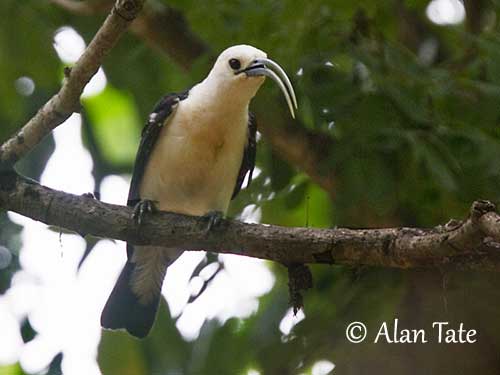
At the beginning of the breeding season, the polyandrous female takes the lead in courtship. She performs some courtship displays when she meets a male, but the male does not offer any display in return.
When she meets a male, the female approaches it and adopts a posture with the body held horizontal. Then, she quivers both wings and tail feathers.
The Sickle-billed Vanga continues both displays and copulations until the eggs have hatched, and also into the brood-rearing period of the cycle.
During the nesting period, both female and males of the group take part in territorial defence, but males do less frequently the usual nesting duties, mainly performed by the female.
The Sickle-billed Vanga is sedentary.
The flight is laboured. During the flight, the large, rouged wings produce a loud, whooshing sound.
REPRODUCTION OF THIS SPECIES:
The breeding season takes place between October and January in NW.
The Sickle-billed Vanga builds a bowl-shaped, loose structure made with twigs, both smooth and thorny ones, placed in tree fork between 9 and 16 metres above the ground. The cup is lined with soft materials such as plant fibres. Spider web may be used to secure the materials. The nest is built mainly by the female, with little help from the males of the group.
The female lays 3-4 creamy-white eggs with dark mottling mainly on the larger end. She incubates during 16-18 days. The nestling period lasts about 19-23 days.
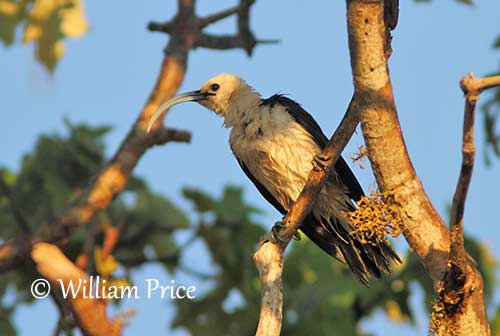
The Sickle-billed Vanga breeds in group including a single female and several males. These males copulate with the female but they are not helpers. This is a co-operative polyandry breeding system.
Usually, the males may assist with nest-building, incubation and chick rearing, but all the males defend the territory and the nest against predators and intruders.
PROTECTION / THREATS / STATUS:
The Sickle-billed Vanga is common to fairly common throughout most of its range, but especially in W and S of the island, in or near forests. It also occurs in several protected areas.
The size of the population is unknown, but the species is not globally threatened.
The Sickle-billed Vanga is currently evaluated as Least Concern.
